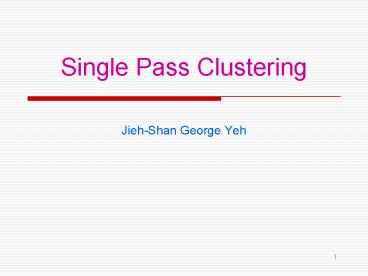Single Pass Clustering PowerPoint PPT Presentation
Title: Single Pass Clustering
1
Single Pass Clustering
- Jieh-Shan George Yeh
2
Example
- Consider the set of documents and terms
- Clustering the terms using the single pass method
(using the term vector columns)
3
Preliminary
- Order the term vectors (column vectors).
- Choose a simplicity function, say, dot product.
- Set a pre-specified similarity threshold 10.
4
Step 1
- Start with T1 in a cluster by itself, say C1.
- At this point, C1 contains only one item, T1.
- the centroid of C1 is simply the vector for T1
C1 lt1, 3, 3, 2, 2gt.
5
Step 2
- Now compare (i.e., measure similarities) of the
next item (T2) to centroids of all existing
clusters. - SIM(T2, C1) lt2, 1, 0, 1, 2gtlt1, 3, 3, 2, 2gt 21
13 03 12 22 11 gt10 - Add T2 to cluster C1.
- Compute the new centroid for C1 (which now
contains T1 and T2). - The centroid (which is the average vector for T1
and T2 is - C1 lt3/2, 4/2, 3/2, 3/2, 4/2gt
6
Step 3
- Now, there is only one cluster, C1, so we only
need to compare T3 with C1 centroid. - SIM(T3, C1) 0 8/2 0 0 4/2 6 lt10
- Therefore, we use T3 to start a new cluster, C2.
- Now we have two clusters
- C1 T1, T2
- C2 T3
7
Step 4
- Move to the next unclustered item, T4.
- SIM(T4, C1) lt0, 3, 0, 3, 5gtlt3/2, 4/2, 3/2, 3/2,
4/2gt 0 12/2 0 9/2 20/2 20.5 gt10 - SIM(T4, C2) lt0, 3, 0, 3, 5gt lt0, 2, 0, 0, 1gt 0
6 0 0 5 11gt10 - SIM(T4, C1) gt SIM(T4, C2)
- T4 will be added to cluster C1. Now we have the
following C1 T1, T2, T4 C2 T3 - The new centroid for C1 is now
- C1 lt3/3, 7/3, 3/3, 6/3, 9/3gt
8
Step 5
- The only item left unclustered is T5.
- SIM(T5, C1) lt1, 0, 1, 0, 1gt lt3/3, 7/3, 3/3,
6/3, 9/3gt 3/3 0 3/3 0 9/3 5 lt10 - SIM(T5, C2) lt1, 0, 1, 0, 1gt lt0, 2, 0, 0, 1gt 0
0 0 0 1 1 lt10 - T5 will have to go into a new cluster C3.
9
Final
- The final clusters are
- C1 T1, T2, T4
- C2 T3
- C3 T5
10
Note
- The results for this method are highly dependent
on the similarity threshold. - The results are also are highly dependent on the
order of vectors. - The computation complexity is O(nk), where n is
the number of vectors and k is the number of
classes.
PowerShow.com is a leading presentation sharing website. It has millions of presentations already uploaded and available with 1,000s more being uploaded by its users every day. Whatever your area of interest, here you’ll be able to find and view presentations you’ll love and possibly download. And, best of all, it is completely free and easy to use.
You might even have a presentation you’d like to share with others. If so, just upload it to PowerShow.com. We’ll convert it to an HTML5 slideshow that includes all the media types you’ve already added: audio, video, music, pictures, animations and transition effects. Then you can share it with your target audience as well as PowerShow.com’s millions of monthly visitors. And, again, it’s all free.
About the Developers
PowerShow.com is brought to you by CrystalGraphics, the award-winning developer and market-leading publisher of rich-media enhancement products for presentations. Our product offerings include millions of PowerPoint templates, diagrams, animated 3D characters and more.

